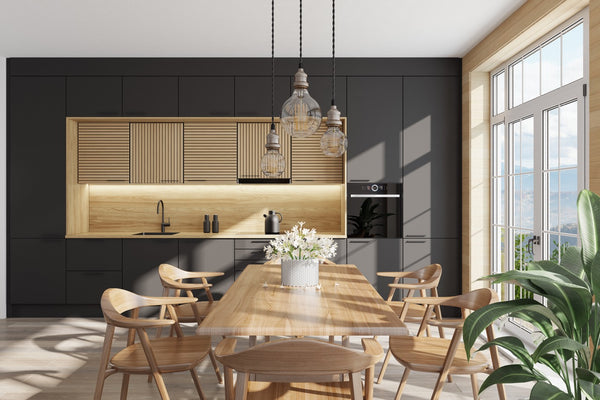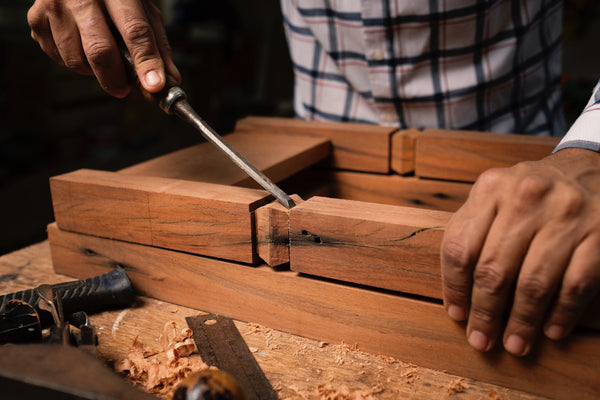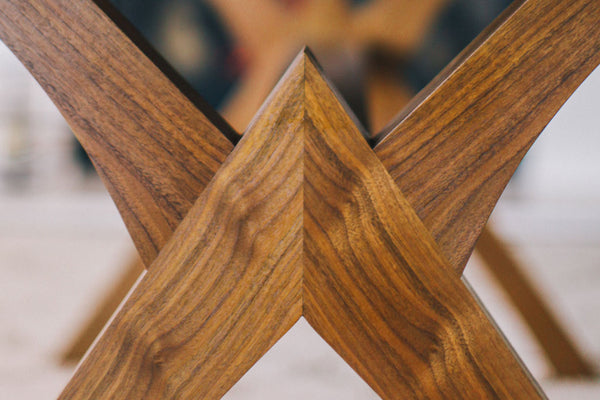9 Furniture styles that will look great in your home and the influences that inspired them

Art reflects ideas, architecture reflects art, and furniture design reflects architecture. How did the popular furniture design we see today come to be, and what were the influences that helped form the style? We have compiled 9 different furniture styles with photos to help you understand how individual styles of furniture came to be, and what distinguishes them from one another.
1. Traditional

There is no furniture design as timeless as traditional. The style began in Europe in the 1600’s and although it has taken many different forms and stylings, it has always remained popular at some level. Where modern and contemporary designs favor simplicity, traditional furniture values extravagant and opulent designs. Historically, the value of a piece of traditional furniture is proportionate to the hours that it took to make it. The more man hours i.e. expense, the more distinguished and stylish the piece became. Although it has many subcategories with varying design details, traditional furniture is generally marked by lavish molding details, rich wood tones, and sophisticated woodwork.
Featured above is our Maquera dining table. The table base is built in a neo-classical style with an Italian white marble tabletop. Although the traditional design rules have not always included stone, the category continues to subtly evolve with the times, and we feel this dining table offers a modern example of this cultured design tradition. The Maquera Dining Table communicates the same sense of refinement, luxury, and elegance that traditional furniture design has offered for centuries.
2. Transitional

Transitional furniture design is a category between categories. It makes up the middle ground between contemporary and traditional design. Furniture that is designed to be transitional is flexible and can class up or mellow out a space depending on what elements are already there. Most simply put, it is a conflation of the tested elegance of traditional design, with the simplicity and popularity of contemporary design. It is a tested ally of homeowners looking to create an elegant yet warm and inviting space in their home.
The Barry Custom Desk is the one of the best examples we have of this design style. The desk has some classic traditional elements displayed through its curved sidewall, brass toe kick, and its framed and trimmed panels. At the same time, there are contemporary influences at play in is its general simplicity, functionality, and sleek design. These two design styles have been married to make an aesthetically pleasing desk designed to remain both luxurious and approachable for years to come. It will serve as a powerful compliment in a variety of room aesthetics and is expected to age well despite the changing style preferences of time.
3. Contemporary

From the 1970’s onward, contemporary is the category we have used to describe what is the popular design style of the day. Contemporary furniture design is largely built on the radical shift of consumer preferences that came in the modern design era (1920-1969). Contemporary and modern furniture both value form over function and simplicity over the ornate. However, where modern design is a closed category, what is considered ‘contemporary” is continuing to be explored and refined.
Because of the undefined boundaries, contemporary furniture from the 1990’s may look somewhat different than the contemporary furniture of the 2020’s. One day the category will be closed and will thus be easier to define, but I will at least try and demonstrate some of the values at play in the contemporary design tradition.
Simplicity is one of the biggest values of contemporary furniture. For hundreds of years, the arts were dominated by tradition. In the furniture world this manifested in centuries of ornate, expensive furniture that was more about status than it's usefulness or comfort. The 1920’s and onward saw one of the biggest design shifts in modern history and this of course manifested in popular furniture design. For the first time centuries, quality furniture came to embrace function over appearance. A piece of furniture that didn’t live up to its function was deemed no piece of furniture at all. This was one of the main tenants of modern furniture design and has carried over into contemporary style. The value of simplicity is visually evident when you look at a piece of contemporary furniture, as it lacks the visual pomp of its forefathers, but is still perfectly crafted to its purpose.
Another value of Contemporary furniture is flexibility. In the previous era of furniture design (mid-century modern), there could be no overlap in styles, and it could even be difficult to coordinate a room within the genera. If you have ever bought a single piece of MCM furniture, you will understand. It only fits in a room if everything else matches it. Contemporary furniture is designed to fit in many settings, even ones outside of its style. Its flexibility is achieved through use of softer lines than the ones seen in the modern era, simple shapes, neutral colors, and the added incorporation of timeless materials like stone and metal. The value of flexibility is also displayed in contemporary domestic architecture as changing values push designers to make homes that could serve a variety homeowner demographics and thus have a more attractive resale value.
At Open Door, over half of the custom furniture we design and build is in the contemporary style, including the Barry Custom Table and Seating above. All custom contemporary furniture built in our shop incorporates solid, quality hardwoods and is designed to last.
4. Scandinavian

Scandinavian style furniture is both easy to identify and popular in today’s marketplace. Like all designs and styles, it is ultimately values motivated. Scandinavian furniture embraces minimalism and is rooted in an organic aesthetic. Natural wood tones are prominent in this design style and are often complimented by natural light and minimal clutter in the room. Because of the less is more value of the Scandinavian tradition, its furniture is designed and built to be standalone in its beauty.
Featured above is one of our builds that we named the “Flood Table”. It is a true embodiment of the Scandinavian design tradition as it sits at the intersection of beauty and simplicity. With its splayed legs, gentle curves, and an alluring stretcher, this table is designed to command a room through its humble appeal.
5. Mid-Century Modern

The mid-century modern furniture design style rose to prominence in 1940’s America, right after the Second World War. The furniture design captures the ‘modernist’ philosophy of the time. Modernist thinkers believed that the world was set toward an inevitably bright future fueled by progressive scientific breakthroughs. Famous furniture designers like George Nelson and Isamu Noguchi began incorporating new and exciting materials into their furniture like plywood, plastics, acrylic, fiberglass, formica, and many others as an intentional embrace and exploration of the future. Their ideology as stated by Charles & Ray Eames was “Getting the most of the best to the greatest number of people for the least amount of money.”
In present day, most original mid-century modern furniture is resting in history. Vintage pieces come up here and there and are sometimes sold for a small fortune. However, the popularity of mid-century modern is still strong, and it has caused many manufactures to recreate or reinvent old designs. A lot of the original building materials like plastic and acrylic have not been reincorporated into the present revival and with their absence has gone much of the mass affordability that the Eames and others had envisioned. What has arisen in its place is a generation of high-quality furniture that captures the inspiration, lines and aesthetics of its forefathers, and is built to endure the test of time.
At Open Door, the first furniture we ever built was in the mid-century modern design style. Featured above was one of the first pieces of furniture Andrew (owner) ever built. Mid-century modern furniture has a special place in our hearts and is always exciting to design and build when a custom commission is made.
6. Craftsman

Technically speaking, every solid wood piece of furniture we build at Open Door could be classified within the craftsman style. However, we’ve chosen to highlight a piece we built that captures some of the more typified classic design details of craftsman furniture. These features include solid hardwood composition, sturdy proportions, and mortise and tenon style joinery.
7. Farmhouse

Farmhouse furniture emphasizes function and is intentionally composed from available materials. The values of farmhouse design emphasize the practical and originally came from hardworking rural communities who tend to have big spaces, close family, and a can-do attitude. Aesthetically, farmhouse furniture tends to be big, sturdy, and simple, owing to its practical roots. In recent years, farmhouse furniture has entered the urban scene and become a popular design style found in homes big and small all over the United States.
Admittedly, farmhouse furniture is not one of the main design traditions that we build in, but I do want to highlight our Carolina Dining Table. Both the design of the legs along with the magnitude and simplicity of the table owe their inspiration to the farmhouse tradition. All it is missing to be a truly inspired farmhouse table is a light finish. However, because of the dark satin finish, the style of the Carolina Dining Table is a fusion of disciplines, and owes its final aesthetic to a more contemporary inspiration.
8. Coastal

Coastal furniture is a small fish in the furniture design world, but commands audience in its proper context. It emphasizes harmony over bold standalone pieces and is designed to reflect some of the greatest beauty that this world has to offer i.e., the ocean. Coastal furniture design is marked by natural materials, natural color tones, and an inside/outside aesthetic. It is a required element for any home that wants to capture the peaceful, organic aesthetic of the coast.
The Weak’s Beach Table featured above is built in the coastal tradition. It features a natural finish on solid white oak. The grooves on the base mimic the slats of outside furniture, although in pursuit of highest quality, they are made of solid hardwood. The tabletop is given a gentle camber around its sides which matches the rounded corners of the base. The gentle curves built into this piece soften the furniture, harmonize it with the space, and contribute a significant element to the vision of the room.
9. Modern

The Modern design school began in Germany in the 1920’s with the Bauhaus movement, although the philosophy and art of the modern era had been being developed since the 1860’s. Modernism reached its peak influence in the furniture design world between the 1940’s and 1960’s in a design period we now call mid-century modern. Modern and contemporary are synonyms in English, but in design they are two different eras. The modern era came to a close in 1969 and gave way to the postmodern era whose art and design styles we now classify as contemporary.
The essence of modern furniture design is rooted in simplicity. The value of simplicity was a bold contrast to centuries of traditional, ornate designs. Along with simplicity, modern design is characterized by minimalism, a general affinity for geometry and shapes both organic and otherwise, and a wide variety of color schemes. Oftentimes the colors of modern design were neutral, but there was space in the Modern school to welcome in vibrant colors to add accents to a space.
This is the case with the Harris bar cabinet. In Modern design tradition, it serves as a colorful accent to the room and contributes some vibrant life to the space. Outside of the bold solid color scheme, the Harris bar cabinet also features simple shapes and lines standard to the modern tradition.
10. Bonus - Custom Fusions

Our Custom Walnut Table and Seating is a bonus that highlights the flexibility of custom furniture. The table and seating shown below straddles the line between two design traditions and is a striking fusion of elements and values.
At first glance, the rich wood components, simple design and splayed legs all suggest a mid-century modern inspiration. Those elements are some hallmarks of that tradition, and the Custom Walnut Table and seating display those features prominently.
At the same time, there are structural metal elements that are not harmonious with the mid-century modern tradition. Metal plates stabilize the table and seating retaliative to the floor, and the seat backs are held up by a shop-fabricated steel skeleton. The way the seat-back is designed gives the piece a “floating” aesthetic. These design elements are most at home in the industrial tradition. By conflating these two disciplines, we kept the core value of simplicity in the mid-century modern tradition while adding the long-lasting durability emphasized in industrial design. This union created a piece that is as durable as it is beautiful and will last as long as the homeowners allow it to.
Fusing and straddling different design traditions is one of the unique freedoms that custom furniture offers. It allows the designer, builder, and commissioner, to partner in creating something that is truly original. If you have a custom furniture commission in mind, we would love to speak with you.
Leave a comment
Comments will be approved before showing up.
Also in The Open Door Blog

17 Foundational principals in Kitchen design

23 Things I Wish I Would Have Known as an Amateur Woodworker
Woodworking is a rewarding hobby, but it is not without its difficulties. We at Open Door Furniture have compiled a list of 23 things you need to know if you're just beginning your journey in woodworking. We hope that you can learn from some of our (and many others) early mistakes and flourish in your own ambitions as woodworkers.








Kyle Lindstrom
Author